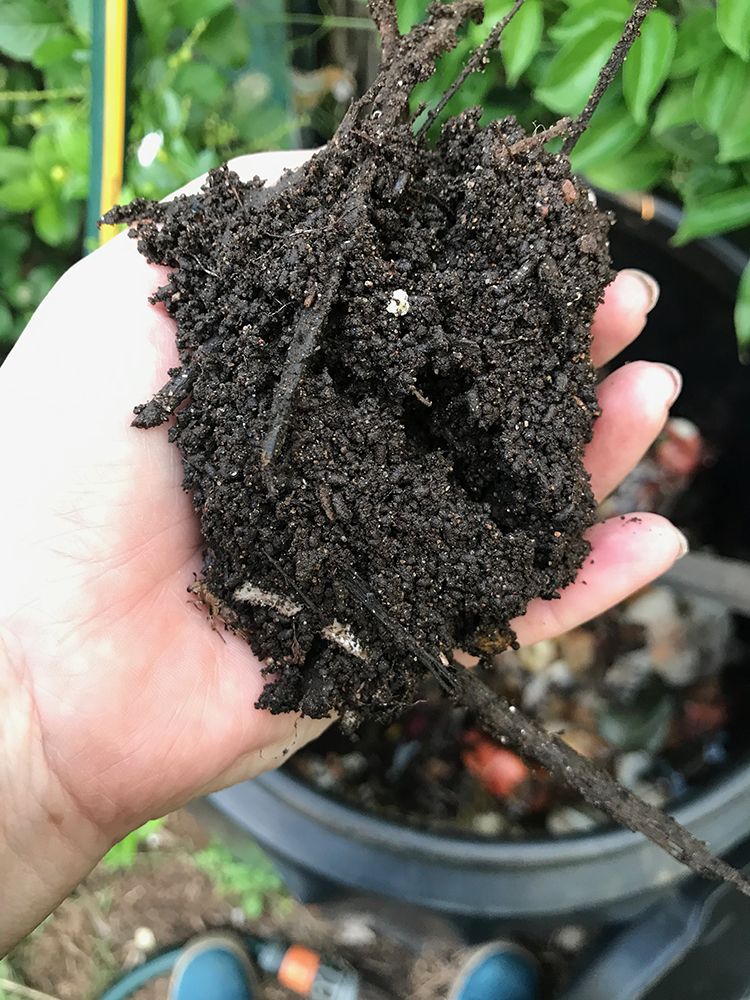By Claire Bickle
What is compost?
Compost can be created from anything that was once living. Naturally occurring composting can take years depending on the materials, but as gardeners we can accelerate this process via a variety of composting methods, in particular hot composting techniques.
Why compost?
Home-made compost is free organic matter that feeds your plants and enriches your soil profile. Adding organic matter to your soil improves the soil health short and long term. It increases the number of good soil microbes and beneficial fungi, which all equate to better plant growth and health. It will also help your soil retain moisture and help absorb and filter water run-off. All whilst reducing your impact on landfill quantities and in turn preventing greenhouse gas emissions and leachate which can pollute land, groundwater and waterways.

Did you know that over half our household garbage is made up of food and garden waste that can be easily composted?
Food and green waste from your home and garden can be composted on-site and then added to the soil to grow more plants, which will potentially produce more ingredients to create more compost. This process is called “closing the loop”.
The how-to of Hot Composting:
Hot Composting is where you incorporate air and water into the composting process. Getting the balance of organic materials right is the key to your hot composting success. The right amount of carbon (brown) and nitrogen (green) components is 25:1. 25 carbon to 1 nitrogen.
Ingredients: Nitrogen; Carbon; Oxygen; Water.
High Nitrogen:
- Vegetable and fruit scraps
- Green grass clippings and leaves, comfrey
- Aged animal manures such as horse, chicken, cow and sheep
- Blood and bone
- Tea leaves and coffee grounds
- Fresh weeds (avoid seeds) and soft pruning’s
- Liquid seaweed and fish emulsion applications
High Carbon:
- Brown leaves
- Sugarcane and straw
- Dried grass clippings
- Shredded paper/newspaper
- Animal hair
- Thin brown pruning’s

The recipe:
Building your compost heap.
- Make your compost heap 1.2m high and 1.2m in diameter.
- Choose a flat surface.
- The first layer needs to be course branches and sticks.
- Then create layers like a lasagne of high nitrogen and high carbon.
- The layers of carbon need to be thicker than the layers of nitrogen. Remember 25:1.
- Hose water in between each layer you lay.
- Turn your completed heap every 3 days so that the internal part of the heap moves to the outside and vice versa. This gets much-needed air into the heap that helps those aerobic microbes break down all that organic material.
- When it all comes together correctly you can make compost in as little as 6 weeks.
- It can take a little trial and error, so keep at it.
Other options:
- Tumbler bins and Aerobins.

Anaerobic composting or Cold Composting
This is a bin set up where kitchen scraps and green and brown garden waste are just placed within the bin of choice and then will slowly break down over time.
Start with course dry material at the bottom, such as sticks to help increase airflow. Composting this way can take up to six months. You can use a compost bin aerator to help speed up the composting process.
Other options:
- Trench composting – simply burying your kitchen scraps and the like in situ within the garden.

What you can add to your compost:
Vegetable and fruit scraps, small pruning’s and lawn clippings, tea bags (staples removed), coffee grounds, vacuum dust, shredded paper, used potting mix, eggshells, old spent flowers.
What you can’t add to your compost:
Meat/bones, fish as this will attract flies and vermin. Dairy products, wheat products, diseased plants, pet droppings, plastic, weeds that have seed heads and underground tubers and bulbs (unless hot composting) should also be avoided.
Super Ingredient: Comfrey
This herbaceous perennial herb is often called a dynamic accumulator because of its deep roots and its capacity to draw up many trace elements from the subsoil. This makes the leaves high in nutrients and a great addition to the compost heap or bin. Comfrey is also classed as a compost activator/accelerator because of this nutrient density.

Compost FAQs
Q: Does my compost bin need to be in the sun to help it compost better?
A: No. It’s the air and the microbes within a hot compost heap that makes the compost hot and break down more quickly.
Q: What are these maggot looking like creatures in my compost?
A: These are usually soldier fly larvae and are great little workers in the compost heap. You will find all sorts of creatures living within your cold and hot compost heaps and the vast majority of them are there to help the composting process.
Q: Why does my compost smell bad?
A: This will be because of an imbalance of ingredients. It could be that your compost is too wet, has too much nitrogen or meat products have been added. Add more carbon ingredients and pull the heap or bin apart to allow for it to dry out a bit.
Q: How long does it take to create good compost?
A: Hot composting heap methods can take as little as 6 weeks. Cold composting bins can take up to 6 months.
Q: How do I stop rats and mice getting into my compost bin?
A: First, place the bin on a piece of rodent-proof mesh or aviary wire. Second, creating a regular disturbance with a compost spiral aerator every few days acts as a good deterrent.

About Claire Bickle
Claire Bickle is a Brisbane based qualified horticulturist with 30 years’ experience. She is passionate about all things horticultural, gardening and sustainability. She is a regular ABC radio presenter, workshop facilitator, educator, writer, speaker and garden tour leader.
Facebook: Claire Bickle Gardening for the Goodlife
Instagram: @clairebicklesgoodlife

